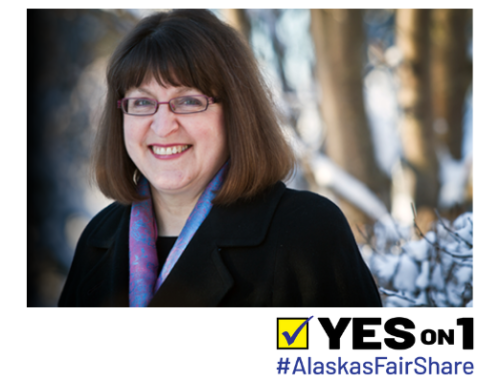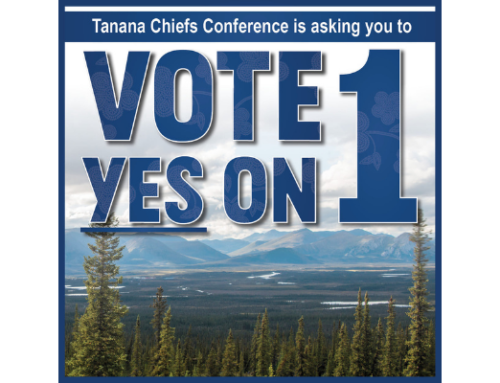Why I support the Alaska’s Fair Share Citizen’s ballot initiative – and a small (one percent) request for education. Please read on, and thank you.

Fairness, honesty, access to relevant facts, and public education are the essential reasons which best explain why I support this ballot measure. Public education about Alaska’s oil fiscal system is important for many reasons.
Fact: Alaskans own the Prudhoe Bay, Kuparuk, and Alpine oil fields on the North Slope. Because we own this oil on state land, we have a right to royalty payments, as owners of the land. We also have rights to a production tax, as the oil leaves our land. These three fields are appropriately referred to as our “legacy fields” because they have produced our Permanent Fund, the vast majority of our oil and our oil wealth, and will continue to do so. Source, “60 Years of Revenue” Revenue Sources Book Fall 2018, pp 49-50, 59.
Here is another item you are not learning about in the “Facts” messaging from the oil industry – Fact: ConocoPhillips reported net income, from just its Alaska North Slope oil production, of 1.5 billion dollars, for calendar year 2019. Source: ConocoPhillips’ Annual Report, filed under Securities and Exchange Commission guidelines dealing with accurate statements for investors, banks, and others. Here is another fact missing from all of those TV and radio and social media ads: Fact: ConcocoPhillips’ net income, on Alaska oil, was 1.8 billion dollars in 2018. And, under those same SEC requirements of accuracy, ConocoPhillips told banks and investors that it had added to its “low cost of supply resource base, including increasing our legacy asset position in Alaska through two separate acquisitions.” Source, ConocoPhillips’ 2018 Annual Report, page 34. It would know whether our oil is low cost compared to our competitors.
ConocoPhillips has a 36% share of our Prudhoe Bay oil. The rest of Prudhoe Bay is almost entirely owned by Exxon (36%) and BP (26%). While Exxon and BP do not want to share Alaska specific information with Alaskans, by reasonable extrapolation, these three international oil companies had many billions of dollars in profits, almost entirely from our legacy oil fields, in just two years, 2018 and 2019. We know this because Exxon and BP have a 62% share of our “low cost” Prudhoe Bay legacy field oil. And we know that the average value of our oil in calendar year 2018 was about 71 dollars a barrel in 2018, and 64 dollars in 2019. Source: ConocoPhillips Annual Reports, pp. 48 and 46. And average daily production from just Prudhoe Bay and its satellite fields averaged more than 250,000 barrels, every day. Source: Fall 2018 Revenue Sources Book p. 137; Fall 2019 Revenue Sources Book 2019 p. 97.
You can do the math at these prices. The gross value of just Prudhoe Bay oil at 71 dollars was over 6.5 billion dollars. at 64 dollars, it would be worth close to 6 billion dollars. 12.5 billion dollars in gross value, just from Prudhoe Bay, in just 2018 and 2019. And this was just half of ANS production. Source: pages 137 and 97 of the Fall 2018 and Fall 2019 Revenue Sources Books.
We are not dealing with some poor oil companies. So, for Alaska charities and other non-profits which try to serve and help Alaskans in need, how much did you receive from Exxon, BP, and ConocoPhillips in these two years? What might have been available from the state, if we had collected just one billion dollars a year from our legacy field production revenues? Perhaps we could have maintained our public school system, university system, or fixed our state ferry system, or helped more with domestic violence programs, head start programs, increased dividends, or all of the above.
Why are you not hearing about these massive profits in all of the messaging coming from oil companies, and their surrogates, like companies who do work for them? The people who do work for these big three international oil companies likely have no idea that these companies are making so much money on our oil, which is their oil too, if they are Alaska residents. Of course, the companies themselves are fully aware of their profits. They just don’t want to share that information with Alaskans – including those they ask to do advertising and messaging against this Fair Share Act. How about getting the facts first, before suggesting that these oil companies cannot handle a production tax increase from zero to 10%?
So why is this very important info about the fairness of our oil fiscal system not appearing in the TV, radio, and social media ads we are all hearing and/or receiving from oil producers and their supporters? Simple. First, listen to the top three supporters of the ad. (Exxon, BP/Hilcorp and ConocoPhillips.) Just that info is a red flag of caution. Unlike the rules relating to accuracy and honesty in reports to investors under Securities and Exchange Commission guidelines, these producers and their PR firms are not under any requirements to be honest in their messaging to owners of oil, like Alaskans. Their job is to get us to give away our oil for as low a cost as they can. They do the usual fear messaging about jobs and the economy, but their activity is based on the price of oil, not our low to non- existent production tax fiscal system.
This helps to explain a lot of things. This profit and low cost info does not fit the producers’ arguments that Alaska is a high cost state to produce oil. Fact check against the info above from ConocoPhillips’ 2018 report; we are a “low cost” place to produce oil. Additionally, it does not fit the argument that we are always trying to raise taxes on the oil companies. Fact check: the last real change we had to oil taxes was in 2013, when, through SB 21 and all of its credits, including an 8 dollar a barrel tax write-off on every barrel of even our existing, producing, legacy field oil, which did not and does not need this “incentive/gift” to produce our legacy field oil, has caused our production tax to go negative at times. It is now from zero to 4%. So of course it is time to raise it from zero.
Whatever oil supporters want to say in terms of a percentage increase – you must really know whether there is a current tax, and what it is, what the credits/tax cuts are, and compare that to what it has been historically. And you must compare it to what other owners of oil charge producers. Permanent fund defenders should be on top of this. We cannot defend the fund or dividends if we are giving away our legacy field oil.
Wondering why we are only hearing from one side of this issue of what is fair to producers but also fair to Alaskans as owners of these legacy fields? Well, they have a lot of our money, and they are better organized. See the ConocoPhillips public record annual reports discussed above. Each billion dollars that we unnecessarily sent to Exxon, BP, and ConocoPhillips, divided by Alaska’s population, amounts to over 1300 dollars a person. So you have already donated to them and paid for their advertising. Fact: Even after their massive profits in 2018 and 2019, Exxon, BP, and ConocoPhillips still racked up a two billion dollar tax write-off from the 8 dollar a barrel credit. And this credit alone is forecast to cost us over one billion dollars in lost revenue, each year, for the ten year forecast out to 2028. Source: Fall 2018 Revenue Sources Book, pp. 105-06.
Fortunately, Alaskans do not need to match the producers’ huge spending on messaging. But Alaskans do need to learn why we need fix our legacy field oil fiscal system. And, here is the very good news. We only need a number of very small donations to help us explain why Alaskans should question the oil industry messaging, and to vote yes for Alaska’s Fair Share this year.
It is important to note that this Initiative is the only option available to the public to increase revenues next year.
Unfortunately, our legislature has failed miserably to fix things. That is why this Initiative was and is necessary.
So here is my very low cost proposal to my fellow Alaskans to help us get the information Alaskans need to fairly evaluate why we need to vote yes for this year’s Alaska’s Fair Share Initiative to Alaskans. For everyone who received a $1600 dividend last year, please donate just one percent, $16, from that dividend to help us save your future dividends and explain why big oil is once again misleading Alaskans about our legacy field oil taxes. This small one percent donation will also help us help Alaskans to understand just how low cost their oil is, compared to the competition. Just one percent will help us to explain and educate Alaskans about what our oil producer partners are spending on our legacy fields, and what their profits are on our legacy field oil.
This is about transparency. It is about sharing accurate, relevant information, rather than hiding relevant information from Alaskans, who own this oil. Just one percent will help us help Alaskans understand that eight dollars for every barrel of oil tax credits, were not, and are not, needed to produce our legacy field oil. You can donate right on this website.
For a couple who received $3200 in dividends last year, one percent would be $32. For a family of four, having received $6400 in dividends, the one percent donation would be $64. From a cost-benefit perspective, what do you have to lose beyond your one percent donation? Nothing. But, what do you have to gain? For every billion dollars in restored revenue, divided by the number of paid PFD applicants in 2018 (639,247), we would have an extra $1564 per dividend recipient. That is a lot of money, over $6,000 for a family of four, and could help Alaskans with all sorts of things, if the Governor and the Legislature decided that they wanted to move all of this restored revenue into the dividend. Of course, the restored revenue can be used for many things.
One thing we all know – without revenue, we cannot pay for dividends, schools or public safety, or anything else. The Permanent Fund is still too small to cover our annual budget, even the reduced one. We need to grow the size of the fund for future Alaskans. Time to think back “in the box” by restoring our Prudhoe Bay/Kuparuk/Alpine legacy fields oil revenue.
Remember revenue? Over the last few years, a lot of it went, unnecessarily, to Texas and England, where Exxon, ConocoPhillips, and BP are headquartered, respectively.
We have a revenue problem. We have fixed whatever spending issues some folks were complaining about. We no longer have a spending issue. Our state budget has been cut so far that legislators from all perspectives and parties have said there are no budget cuts left, or further budget cuts that their constituents would want them to do, especially after learning what would be lost with even further cuts. We also have a savings issue, which is related to our failure to collect revenue.
Our legislature is not allowed to do the obvious thing – to fix our legacy field oil fiscal system. Shamefully, and outrageously, so complete is the oil industry control over “our” legislature, that the legislature intentionally rejected Robin Brena’s offer to explain what this Initiative will do after it is enacted. Mr. Brena is a longtime Alaska oil and gas attorney. He knows about tax structures dealing with our oil. Besides running deceptive and irrelevant messaging, the industry’s game plan goes so far that it shuts down our public discussion of the pros and cons of our oil fiscal system – in our own public body – the legislature.
To fix our legacy field oil fiscal system, we must do it ourselves, as citizens, through this Initiative. We must educate ourselves and we must share this information with Alaskans. And then we need Alaskans to vote yes on this year’s Alaska’s Fair Share ballot Initiative. When private interests control our legislative and executive branches of government, our Constitution provides that the “people may propose and enact laws by the initiative. . . .” Article 11, Section 1. If there ever was a time for the people to restore their legacy field production revenues, it is now.
Here is another thing that you are not learning from the producers’ “fact” ads. Fact: in 2017, corporations received a huge federal tax cut of 40%. The federal corporate tax was cut almost in half. This makes our oil, at any price, more valuable.
It is not a small amount of money for these large corporations. It is a highly relevant new matter, which was not present when producers lobbied for the SB 21 tax cut in 2013. ConocoPhillips, in its 2018 Annual Report, page 48, stated that its Alaska 2018 results, as compared to 2017, were partially offset by “the absence of an $892 million tax benefit from the revaluation of allocated U.S. deferred taxes at a lower federal statutory rate, in accordance with the Tax Legislation enacted in 2017.”
Fact: ConocoPhillips had higher profits from our oil in 2018, 1.8 billion, vs the rest of the Lower 48 states, 1.7 billion. For 2017, they reported net income of 1.4 billion from our Alaska oil, vs a loss of 2.3 billion dollars from our competitor oil owning states in the lower 48 states. And in 2016, while reporting net income of .319 billion dollars on Alaska oil, ConocoPhillips again reported a two billion dollar plus loss from operations in our competitor states. Source: ConocoPhillips 2018 Annual Report, page 42. Those oil owners apparently do a much better job of learning about what a competitive oil fiscal system is, especially at lower oil prices, and what producers will pay. We are effectively subsidizing Texas and other states with our “low cost” oil. And our legacy field oil is conventional, not shale.
The cost to produce and ship our Prudhoe Bay oil is much lower than most Alaskans realize. This is partially related to the producers owning not only lease rights, but the Trans-Alaska Pipeline, and maritime shipping interests, to keep more costs and profits in-house, as it were. Prudhoe Bay is the largest conventional oil field in North America. It will continue to produce hundreds of thousands of barrels, daily, for years to come, with limited costs. This circumstance used to be good for both Alaska and our oil producing partners. That changed with the passage of SB 21, which eliminated our production revenue. Producers had a “Renaissance” in their corporate profits, even at relatively low oil prices. Alaska’s oil revenues went into the dark ages. The legislature continues to pretend that they have no idea what happened to our production revenue. Passing this Initiative helps to restore balance and stability in our legacy field oil fiscal system. This is good for producers, and for Alaskans.
What is really missing is transparency. Transparency provides the facts and evidence needed for fairness and good public policy. We have allowed Exxon and BP/Hilcorp to hide their Alaska specific profits and expenses from the owners of the oil – Alaskans. There is no good reason for this. A general suggestion that they would like to hide this info for proprietary and competitive reasons is just that: an unsupported suggestion. They are likely very well aware of each other’s costs and expenses. These suggestions are just superficial efforts to keep Alaskans, including industry subcontractors, blind in terms of how much money our producer partners are making on our oil. The Initiative fixes this by making these records public. It is our oil. What could be more fair than that?
Here is one wonderful thing, from our state constitution. Recognizing that Alaska had been a resource rich territory, with outside business interests preferring to pay as li le as possible for taking those resources, our state constitution provides us with several ways to protect our interests when outside business interests seek to buy our state oil resources at below market cost. One of those is the Initiative process mentioned above. And, in Article 8, Section 1, our Constitution states that it is the policy of the State to encourage the settlement of its land and the development of its resources by making them available for maximum use consistent with the public interest.
The “consistent with the public interest” is important language. Since SB 21, we have paid more in production credits than we have received in production revenues. This is not “consistent with the public interest.” For more details on this, please read Robin Brena’s article entitled “Oil Taxes? What oil taxes?”
And we still have a statute on the books which requires us to give producers a direct cut to our Alaska production revenues —all the way up to $150 a barrel. But producers and their supporters say “no changes” to our oil fiscal system. Nonsense. SB 21 was written by producers, and our legislative and executive branches of state government looked the other way, while they gave our legacy field oil wealth away.
Unfortunately, our state government continues to be controlled by big oil. Even as recently as March 20, 2019, the ADN headline and related article noted that Koch Industries AFP and Alaska business groups were sponsoring “our” public budget roadshow. These groups are not interested in Alaskans. They are interested in profits. That is how capitalism works. It is up to Alaskans to understand this, and to protect our own interests, so we at least receive a fair share of our publicly owned legacy oil field production revenue.
The producers understand this. No matter how low cost our oil is, compared to the competition, it is not in their nature or interests to say to Alaskans that producers support this ballot initiative. Alaskans, as owners of huge conventional oil fields, need to educate themselves about what Alaska’s oil fiscal system is and should be, and what competitors are charging for their oil. Alaskans really need to learn about how producers can move our legacy field profits away from our state oil revenue stream. Alaskans are paying for a lot of things they should not be paying for, from our legacy field oil. This revenue needs to be restored so we can stop spending the very last of our savings.
The producers will go with their standard fear messaging, loss of jobs, bad economy, recession, unemployment, etc. But they will never note that these matters have nothing to do with our oil fiscal system. They have already cut jobs and production.
And the economy is in bad shape right now due to the viral pandemic and an oversupply of oil. These are temporary ma ers. We need our regular legacy field oil revenue restored, even when that is just 10% when our oil is at 50 dollars a barrel or less. Better 10% of whatever the price of oil is, than zero. Other oil owners do not subsidize producers like we do.
So, the basic question is whether the provisions of SB 21 are “consistent with the public interest” as required by our Constitution. It is easy, when you have the relevant information, (which has nothing to do with the “facts” you see in those tv ads, articles or social media messages, and everything to do with the facts they leave out), to understand that we need to enact the Alaska’s Fair Share Initiative this year. Once we understand the relevant information, and understand that we are the owners of these legacy fields, we can fix this.
So when someone asks you to just trust oil companies to tell us what is fair, or that we should not make any changes to our oil fiscal system, without even knowing what our oil fiscal system is, or how it relates to the competition, or what their profits are, refer them to this website. That way, they can learn about our tax rate of zero to four percent, barrel credits, producer profits, and how the industry keeps very important information from Alaskans. They are not being fair, because they don’t have to be fair. We expect to provide a lot more relevant information and details over the next few months.
Can you help us help you get the relevant facts with just that one percent, $16 dollar donation per last year’s dividend? It will return a great deal more value to you than any other $16 you can spend or donate this year. Alaska is at a critical point with spending from savings. We are headed down a road of poverty, if we do not restore our traditional Prudhoe Bay, Kuparuk and Alpine legacy field production revenue. And there are no good reasons for doing this to ourselves.
Let’s begin to restore the Alaska we knew and loved, where we had revenue to pay for things, to save money in the Permanent Fund for future Alaskans, and to help those who needed help. Please donate, and vote “Yes” for Alaska’s Fair Share this November. Thank you.
~David Carter, Retired Attorney, Anchorage.
[give_form id=”385″]




